Menu
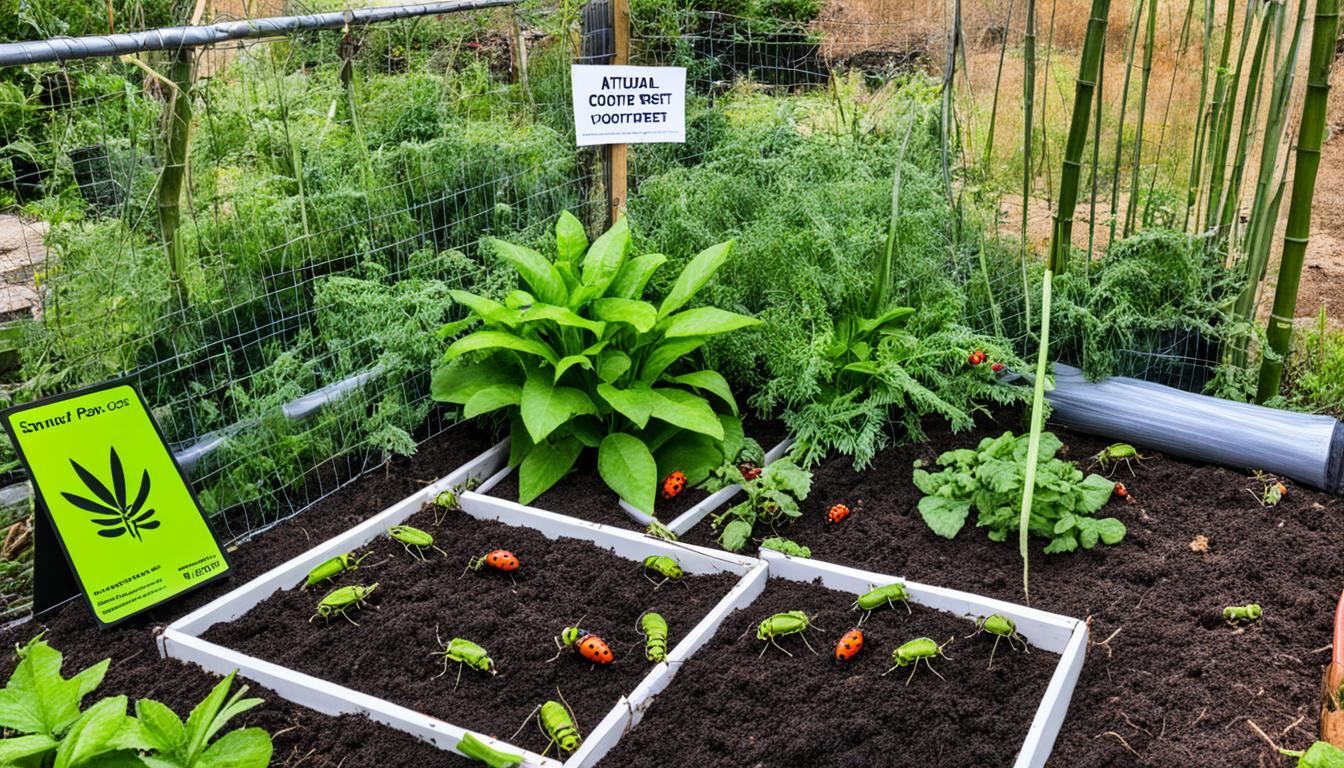
Integrated Pest Management (IPM) doesn’t just prevent pests; it also aims to reduce harm to nature. This approach is vital for a healthier planet and a greener future. Instead of using harmful chemicals, IPM and similar strategies focus on natural solutions. These include using things like peppermint oil and vinegar to keep pests away.
By using IPM and natural repellents, companies like Palmetto Exterminators protect both people and the planet. They avoid harmful products, making homes safer and the earth healthier. Thanks to them, we can fight off pests without hurting our environment.
Eco-friendly pest management is vital for us and our planet’s health. It means using pest control methods that are not harmful. By doing this, we reduce the bad effects on everything around us.
Regular pesticides often cause harm to our environment. They can get into our water, hurting fish and plants. Yet, eco-friendly ways like IPM work with nature to control pests, keeping good bugs safe. This shows us how important it is to choose eco-friendly options.
Gardening in a way that nature likes can cut down on needing pesticides. Placing plants right, adding compost, and checking soil’s acidity can help keep pests away.
Choosing eco-friendly pest management means we’re taking care of our health too. Traditional pest control can sometimes make us sick. But using safe, earth-friendly methods avoids these problems.
Using eco-friendly pest management can also prevent pesticide poisoning. Companies like Palmetto Exterminators use friendly ways to get rid of pests without risking pets or people. This keeps our homes safe and our environment clean.
To sum up, going green with pest control helps our planet and us. It stops pollution and keeps us safe from dangerous chemicals.
| Aspect | Traditional Pest Control | Eco-Friendly Pest Control |
|---|---|---|
| Environmental Impact | Significant chemical runoff, waterway pollution | Minimised ecological disruption |
| Health Risks | Skin, eye, respiratory issues; pesticide poisoning | Non-toxic, safer for humans and pets |
| Effectiveness | Potential pest resistance | Targets specific pests, protects beneficial insects |
| Maintenance | Requires frequent chemical treatments | Long-lasting, minimal intervention needed |
| Sustainability | High environmental footprint | Biodegradable, lower carbon footprint |
Integrated Pest Management (IPM) is a green way to deal with bugs while reducing risks to health and the earth. It uses a mix of methods like biological ones and eco-friendly chemicals. This means pests are controlled in a way that’s not harmful to people or the environment.

Inspection and monitoring are key parts of IPM. They help spot which pests are around, how many there are, and how bad the problem has gotten. This info is crucial for choosing the right eco-friendly treatments. Plus, it lets us see if these methods are working.
Preventing pests from becoming a big issue is at the heart of IPM. It involves steps like planting types of plants that are not easily attacked by bugs or adjusting when you plant things. By doing these before the pests strike, it’s possible to keep them in check. This approach cuts down on the need to use harmful chemicals.
If pests get out of hand, IPM uses treatments that are safe for the environment. These might be plant-based poisons or natural enemies of the pests. These methods are special because they only attack the problematic pests. They don’t hurt helpful bugs or the place where they live.
IPM doesn’t end after treating pests once. It’s about checking often to make sure the methods are still working. By keeping a close eye and changing the plan as needed, we can keep pest levels low without causing harm. This way, the approach supports the environment in the long run.
Using natural pest deterrents at home is key to green and safe solutions. Choosing eco-repellents for your home keeps it free from pests. This way, you won’t worry about harmful chemicals.
Peppermint oil is great for keeping spiders and ants away. Mix it with water and spray where you need. This will stop pests from coming in.
Diluted vinegar is a top choice for those who prefer green pest control. It’s easy to use and keeps various bugs out. The vinegar’s smell confuses the insects, making it hard for them to find their way in.
Citrus peels, from oranges and lemons, are strong natural repellents. They’re especially good against ants and spiders. Place the peels where pests might enter to keep them away.
Various essential oils work well to keep pests out. Lavender, eucalyptus, and tea tree oils are a few good options. Use them in a diffuser or mix them with water to make a spray. This will help guard your home against bugs.
Using these green repellents makes your home safer and supports the planet. You won’t need to worry about harsh chemicals. This is good for both your family and the environment.
In our journey for better solutions, biological pest control shines as a green tactic. This method taps into natural systems for pest management, avoiding chemical use. It keeps ecosystems in harmony without harsh interventions.
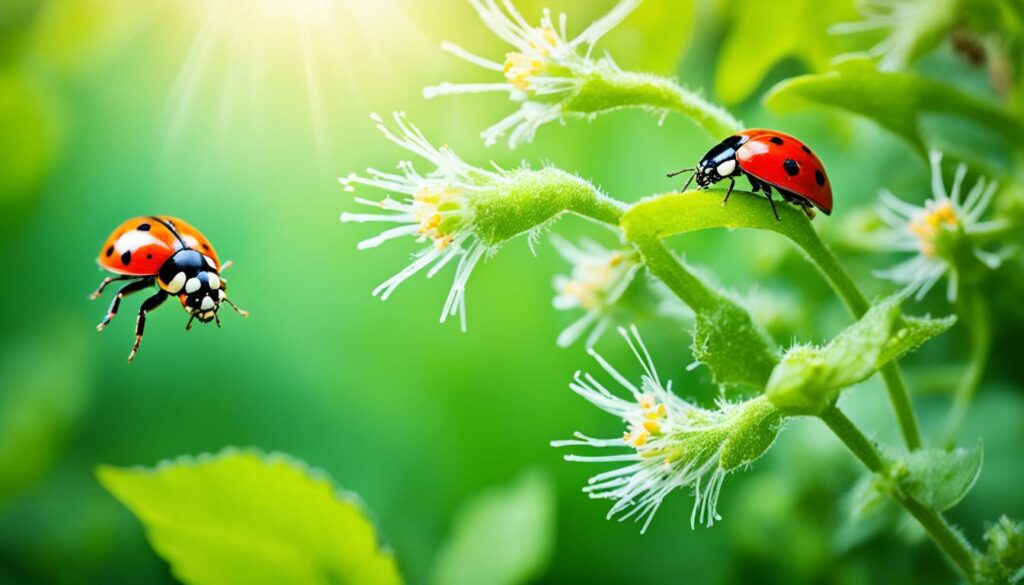
Using natural predators is a smart move. For example, introducing ladybugs can keep aphids under control. This method, known as classical biological control, is safe for nature. It fights pests with their own enemies, a strategy proven to work.
Nematodes, tiny roundworms, offer another push against pests. They go after those that live in the soil, like grubs and weevils. This way of pest control is safe for the environment. It makes the soil healthier and cuts down on the use of chemicals. Plus, using lots of these agents can boost crop yields by up to 20%.
Another tool in the kit is Bacillus thuringiensis, or Bt for short. It’s a bacterium that acts as an insect killer but doesn’t harm friendly insects. Bt attacks the larvae of pests, causing them to die. This method supports the growth of natural predators, a win for ecological balance.
I use physical barriers and traps for pest control. They help me limit bugs at home without using harmful chemicals. I find them to be safe for both my family and the planet. There are many options, from door sweeps to sticky traps.
Door sweeps and screens are the first defence. They seal off openings under doors and strengthen window screens. This keeps almost all pests outside. It’s a simple step but it makes a huge difference in keeping the bugs away.
Sticky traps catch crawling pests like cockroaches very well. They are part of my essential tools for keeping pests under control. I put them where pests usually gather. This is a safe way that avoids the use of chemicals.
Light traps work well for flying pests. They attract insects with ultraviolet light and then catch them. These traps are part of my eco-safe pest control plan. They help keep flying bugs at bay without using harmful materials.
| Method | Effectiveness | Target Pests | Eco-Friendly Nature |
|---|---|---|---|
| Door Sweeps and Screens | 95% | Various Insects and Rodents | High |
| Sticky Traps | 75-90% | Cockroaches, Silverfish | High |
| Light Traps | Variable | Flying Insects | High |
Making your own pest repellents from everyday spices is both ecological and efficient. Cinnamon, cayenne, and cloves pack a punch and work well. These spices also keep your home safe without harmful chemicals.
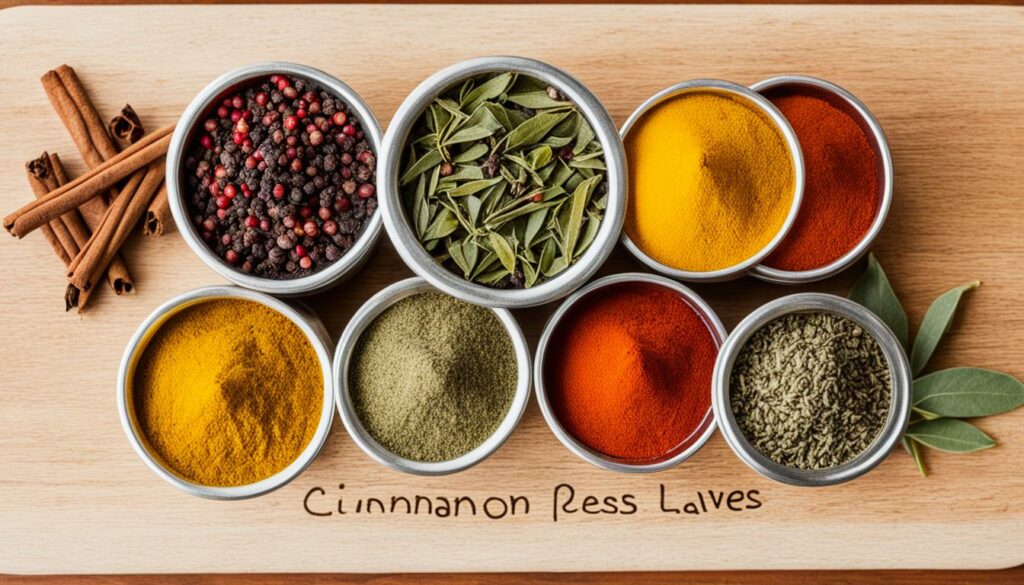
Try mixing ground cinnamon or cayenne pepper with water. This keeps pests away from your home’s entry points. Cloves are great too; they have a strong smell that many insects don’t like.
For an even better pest control, mix these spices in different ways. Find out which combinations work best for your home. This helps you avoid pests naturally, making your living space both greener and cleaner.
This homemade method is also cheaper and uses items from your kitchen. It avoids the toxins in other commercial products. That’s a win for both saving money and for the planet.
Repurposing food waste for pest control is smart and good for the planet. You can use things like citrus peels and coffee grounds. They help keep pests away in a way that doesn’t harm the environment. These methods cut down on waste and offer a safe way to manage pests.
Citrus peels can keep ants and spiders at bay. They smell strong and their acid is natural pest deterrent. Coffee grounds do the same for slugs and snails. Using rubbish for pest control helps keep trouble away naturally.
Putting food waste to use is good for the earth and your wallet. It means you don’t need to use chemicals that can hurt nature and us. These natural methods help manage pests and keep our families safe.
The states of Texas, Oklahoma, Mississippi, and Louisiana are big on eco-friendly pest control. They use natural ways like using food leftovers to keep pests in check. This helps keep the planet healthy for all of us.
| Food Waste | Target Pests | Effectiveness |
|---|---|---|
| Citrus Peels | Ants, Spiders | High |
| Coffee Grounds | Slugs, Snails | Medium |
| Onion Skins | General Garden Pests | Moderate |
| Banana Peels | Aphids, Garden Pests | Low to Moderate |
Using food scraps can lessen the use of harsh chemicals. This benefits our spaces and the whole environment. It’s a small but important way to care for our world.
The use of beneficial pests is key for keeping the balance in agriculture and gardens. Creatures like ladybirds, green lacewings, and parasitoid wasps help a lot. They keep pests in check, making sure our ecosystems stay strong without the need for harmful chemicals.
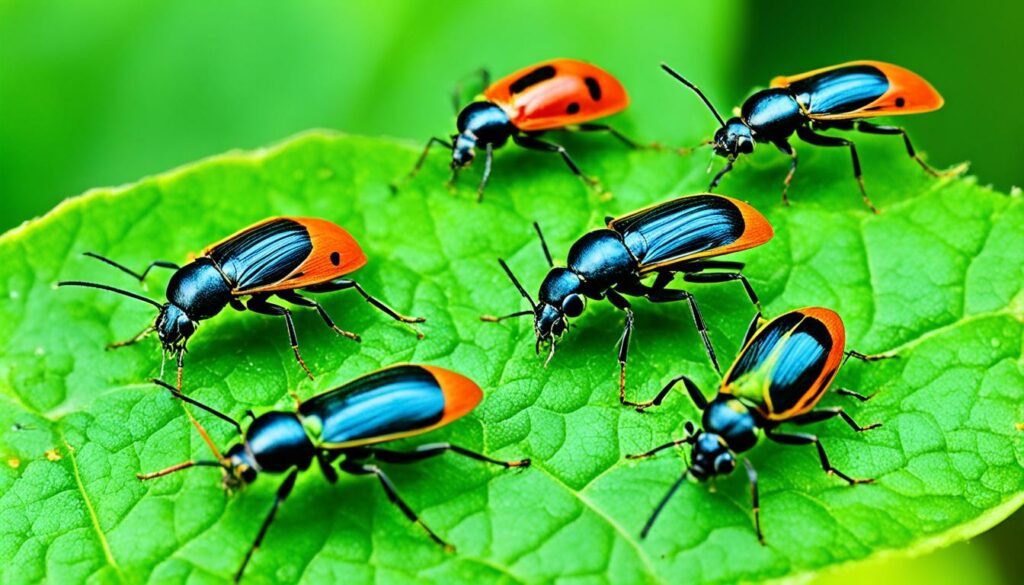
These good bugs are vital for keeping harmful pests off our crops and plants. Ladybirds are great for eating aphids. Green lacewings tackle aphids, thrips, and caterpillar eggs. And parasitoid wasps go for whiteflies, aphids, and caterpillars.
This method is part of Integrated Pest Management (IPM). It uses beneficial insects for eco-friendly pest control, minus the toxins.
To draw these helpful bugs to your garden, tweak the habitat and plant specific flora. A good home for them means better pest control. Ways to do this include planting a variety of plants, using mulch, and cutting back on pesticides.
It’s also about knowing what these beneficial pests need. This ensures they work well with other pest control tactics. By inviting them, we improve our ecosystem’s health and manage pests.
Choosing organic pest prevention over conventional methods means opting for safer control techniques. These methods don’t put people or pets at risk with toxic chemicals. Each year, about 3 million people suffer from pesticide poisoning. Additionally, pets face life-threatening risks because of these chemicals.
Organic pest prevention stands out because it’s safe for both people and their pets. Unlike traditional pesticides, which are dangerously toxic, these natural solutions are safer. Essential oils and useful organisms keep our homes safer without the risk of poisoning. Organic methods, like using neem oil and garlic, help in keeping the environment balanced without harming other organisms and the surroundings.
Organic pest control also provides solutions that work well over time. Regular pesticides need frequent use because pests get used to them. But, methods like diatomaceous earth and planting certain plants work long-term without these downsides. This approach creates an atmosphere that’s not good for pests, and it saves money by preventing big problems later on.
But the real value of choosing organic isn’t just their immediate results. It’s about choosing methods that are good for the future. These methods protect our homes, health, and the world by being eco-friendly and sustainable.
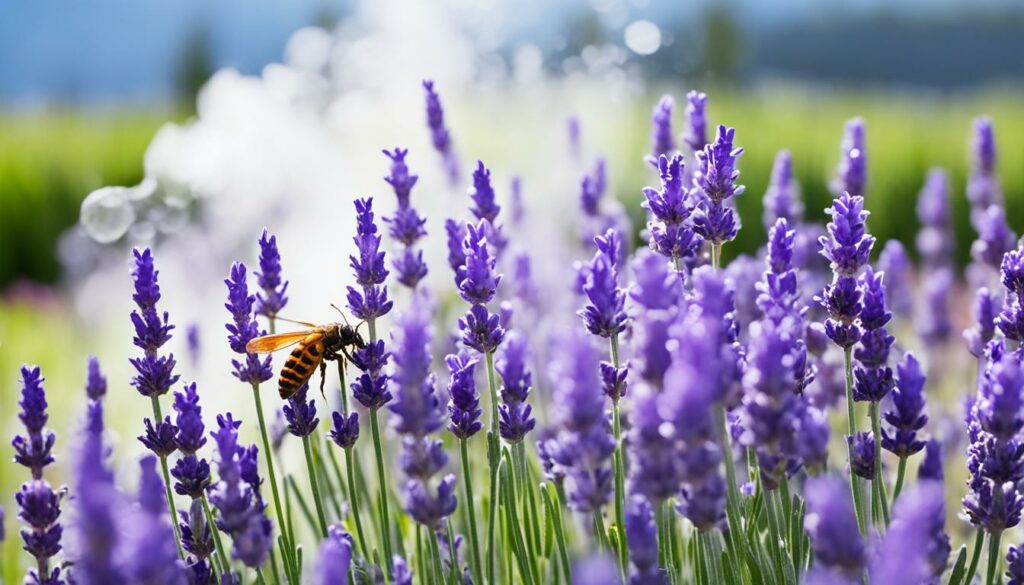
Essential oils are becoming popular for fighting pests because they are safe for the environment. They are natural extracts from plants like leaves, flowers, and roots. These oils can keep pests away very well.
Some essential oils work great in controlling pests. Science has shown their power against bugs is as good as or better than chemicals. For example, lavender oil stops mosquitoes and flies, and peppermint oil fights ants, spiders, and mice. Eucalyptus oil keeps flying bugs off, and tea tree oil is tough on bed bugs. Plus, lemon oil helps against fleas and ticks.
There are several ways you can use essential oils to deal with pests. Here are some methods:
To use essential oils safely, always blend them with carrier oils or water. Don’t forget to check which oils are safe for pets and kids. And make sure they can’t swallow the oils or get them on their skin.
| Essential Oil | Pests Repelled | Application Method |
|---|---|---|
| Lavender Oil | Mosquitoes, Flies | Diffuser, Spray |
| Peppermint Oil | Ants, Spiders, Rodents | Spray, Pet Collar |
| Eucalyptus Oil | Mosquitoes, Flying Insects | Spray, Diffuser |
| Tea Tree Oil | Bedbugs, Mites | Spray, Cleaning Solution |
| Lemon Oil | Fleas, Ticks | Spray, Pet Collar |
Gardening can thrive with eco-friendly pest control. Using natural methods is key. A ladybird can eat up to 300 aphids a day. This cuts the need for harmful chemicals and protects the ecosystem.
Removing pests by hand is effective. Check your plants weekly to catch pests early. Insecticidal soaps break down soft insects without hurting the environment.
Choosing the right spot to plant can ward off pests naturally. Using natural sprays like pyrethrum is also effective. These methods have been used for ages to control pests organically.
Options like Bacillus thuringiensis (Bt) and diatomaceous earth work well. They kill pests but are safe for us and our pets. This makes gardening safer and greener.
Using natural pest control protects all garden life. Traditional pesticides can harm bees and butterflies. Eco-friendly methods are more effective in the long run.
Natural pest control keeps our soil and air healthy. It stops pests from becoming immune to chemicals. This leads to a balanced and eco-friendly garden.
Natural pesticides are becoming the go-to for sustainable pest control. They are a great option instead of using synthetic chemicals. Plus, they help keep our environment safe.
Pyrethrum sprays come from chrysanthemum flowers and are great for fighting bugs. They are not very harmful to people or animals. Also, they vanish quickly in the environment, which is good for the planet.
Microbial insecticides use bacteria like Bacillus thuringiensis (Bt) to stop insects. They target only the harmful bugs. They are safe for the earth and can even improve soil health.
Using natural pesticides is key for greener farming and gardening. It makes our food safer and our planet healthier. So, it’s a win for everyone.
Green pest control makes our fight against pests more effective and safer. It uses natural, non-toxic choices. This is great for many reasons.
Green pest control is good for your wallet. Using traditional chemicals can drain your funds. But green methods mean you spend less over time. They also stop big pest outbreaks, saving you from costly repairs.
Old ways of fighting pests can leave toxic residues behind. These can harm people, pets, and the environment. Green pest control cuts this risk, making places safer for all.

Choosing green pest control also helps the planet. Traditional pesticides can harm the air we breathe. But eco-friendly solutions don’t, keeping the atmosphere clean for everyone.
| Green Pest Control | Traditional Pest Control |
|---|---|
| Cost-effective over time | Frequent, costly treatments |
| Minimises chemical residues | Leaves harmful residues |
| Reduces VOC emissions | Contributes to air pollution |
| Safer for humans and animals | Associated with health risks |
Green pest control is all about using the Earth’s own materials. It’s both safe and long-lasting. This makes it a strong choice against traditional chemical methods.
It’s key to use eco-friendly practices at home for a healthy environment. This isn’t just good for keeping pests at bay. It also means living in a way that’s good for the planet. You can do a lot by just cleaning regularly and using natural products.
Simple cleaning often with safe products can stop bugs invading. Natural stuff like vinegar, baking soda, and essential oils scare pests away. They clean well and won’t harm your family or Earth.
This kind of cleaning cuts down on dangerous chemical use. These chemicals can hurt us, causing anything from a rash to cancer.
For bug control, choosing green options is vital at home. Natural products work well and are not toxic. You can use things like citrus peels, coffee grounds, and cinnamon to keep bugs away.
Using these kinds of products means less nasty chemicals in your life. It’s better for you and the natural world around you.
More and more people are choosing natural sprays to fight bugs these days. This is great for keeping the planet and our homes healthier. In places like Texas, Oklahoma, and more, folks are making a change to eco-friendly pest control.
In short, going green at home with regular cleaning cuts back on pests. It also makes your home a safer place to live in for everyone.
Choosing sustainable pest control is vital to protect our homes and planet. Eco-friendly methods are a big deal in pest management. In 2019, insects held almost half of the pest control market.
North America took the lead with USD 9.59 billion, thanks to more buildings and top pest companies. The Asia Pacific, driven by urban growth, will see big changes. People are spending more on green pest solutions.
With many companies worldwide, the market is competitive. Leaders like ServiceMaster and Rollins Inc. keep ahead through innovation. States such as Texas are into eco-friendly pest control for health and environmental reasons.
Going green in pest control sets a good example for living responsibly. It fights pests now and protects our future. More people want eco-solutions, showing a shift to safer, greener living.
This type of control protects our environment and makes living spaces safer by avoiding toxic pesticides. Integrated Pest Management (IPM), natural deterrents, and eco-traps keep pests under control nicely.
Eco-friendly methods use non-toxic solutions and natural repellents. This keeps our planet safer by reducing harmful chemicals and protecting beneficial wildlife. It keeps ecosystems in balance.
IPM focuses on prevention and uses non-toxic treatments. It checks pests carefully, adds safeguards, and reviews regularly. This eco-method keeps both pests and harm away.
Natural repellents include things like peppermint, vinegar, and citrus. Lavender, eucalyptus, and tea tree oils also work. They’re safe and help keep your home pest-free.
It lets nature’s own helpers tackle pests without harm to the environment. For example, ladybugs eat aphids, nematodes handle ground pests, and Bacillus thuringiensis (Bt) deals with larvae.
Using things like door sweeps, screens, and sticky or light traps work. They’re safe for the Earth and keep pests out without harsh chemicals. ECO-friendly all the way.
Yes, spices like cinnamon and cloves are great mixed with water. They create a spray that pests don’t like. It’s a simple, safe way to keep pests away.
Citrus peels and coffee grounds work as repellents because they are smelly to pests. This also reduces waste at home and helps manage pests in a natural way.
Beneficial insects naturally keep the pest population in check. By welcoming them through certain plants and habitats, our natural surroundings get stronger and healthier.
Organic ways are safe, keeping you and your pets out of harm’s way. These methods also outsmart pests, keeping them away for good and not allowing them to resist.
Rosemary, peppermint, and clove oils work wonders. They can be used directly, mixed in sprays, or even diffused. A natural and versatile way to manage pests.
Start with healthy soil and the right plants. Spices and natural fertilisers also help. These eco-ways are great for keeping your garden and its visitors happy.
Pyrethrum from chrysanthemums and Bacillus thuringiensis (Bt) are two examples. They’re kind to the Earth and get rid of pests effectively.
It’s cheaper, needs less treatment, and makes homes safer from residues. Using nature’s ingredients means a healthier planet and home.
Use natural cleaners, manage waste well, and pick non-toxic cleaning products. It’s an easy way to protect your family and the environment.